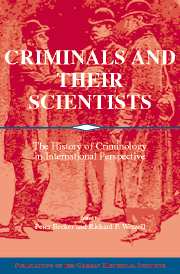Book contents
- Frontmatter
- Introduction
- Part One Nonacademic sites of Nineteenth-Century Criminological Discourse
- Part Two Criminology as Scientific and Political Practice in the Late Nineteenth and Early Twentieth Centuries
- Part Three The Making of the Criminologist
- Part Four Criminology in the First Half of the Twentieth Century: The Case of Weimar and Nazi Germany
- 18 Criminology in Weimar and Nazi Germany
- 19 The Biology of Morality: Criminal Biology in Bavaria, 1924-1933
- 20 Criminals and Their Analysts: Psychoanalytic Criminology in Weimar Germany and the First Austrian Republic
- 21 Drinking and Crime in Modern Germany
- Index
19 - The Biology of Morality: Criminal Biology in Bavaria, 1924-1933
Published online by Cambridge University Press: 05 January 2013
- Frontmatter
- Introduction
- Part One Nonacademic sites of Nineteenth-Century Criminological Discourse
- Part Two Criminology as Scientific and Political Practice in the Late Nineteenth and Early Twentieth Centuries
- Part Three The Making of the Criminologist
- Part Four Criminology in the First Half of the Twentieth Century: The Case of Weimar and Nazi Germany
- 18 Criminology in Weimar and Nazi Germany
- 19 The Biology of Morality: Criminal Biology in Bavaria, 1924-1933
- 20 Criminals and Their Analysts: Psychoanalytic Criminology in Weimar Germany and the First Austrian Republic
- 21 Drinking and Crime in Modern Germany
- Index
Summary
Faced with growing crime and recidivism rates after World War I, Bavarian penal officials in 1920 introduced a “progressive system” (Stufensystem) in prisons, whereby inmates were classified according to “corrigibility” and placed into appropriate “steps” or “levels” (Stufen), each with corresponding rights and privileges. The idea behind the system was to separate hardened criminals and recidivists from occasional criminals, many of whom were driven to crime by the hardships of the war. By 1923 the progressive system was in trouble, foundering on an ill-defined classification method and an inmate population clever enough to exploit its weaknesses. At this point the prison doctor at the penitentiary in Straubing, Dr. Theodor Viernstein, suggested that “biological” criteria be used to evaluate and classify prisoners in the progressive system. Drawing on a rich legacy of criminal-anthropological and criminal-psychological theories, Viernstein argued that a thorough medical and psychological evaluation of an inmate would provide the precise “scientific” classification of prisoners that the progressive system required. As a result, in 1924 a Criminal-Biological Service (Kriminalbiologischer Dienst) was established in Bavaria, which eventually collected over 20,000 “criminal-biological evaluations” (kriminalbiologische Gutachten) of prison inmates that contained information about more than 100,000 family members and associates throughout Germany. These evaluations were used in criminal and civil cases, and even by local authorities in such matters as issuing driver's licenses.
- Type
- Chapter
- Information
- Criminals and their ScientistsThe History of Criminology in International Perspective, pp. 425 - 446Publisher: Cambridge University PressPrint publication year: 2006
- 7
- Cited by



